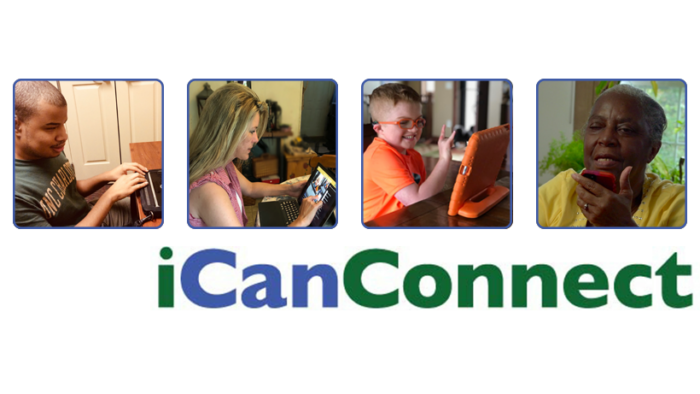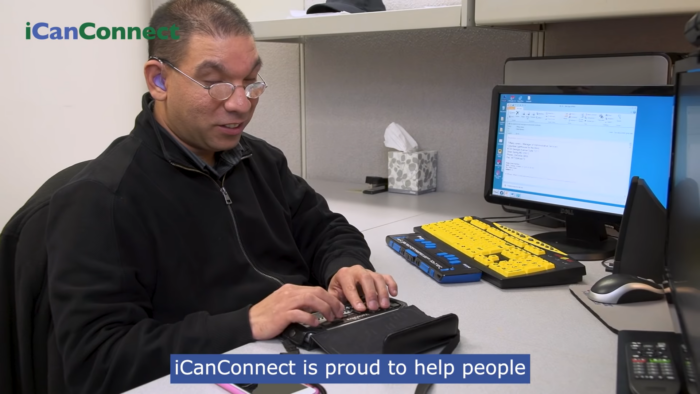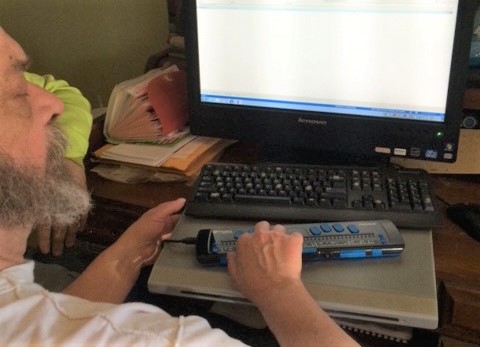
Nearly 40 years ago in the summer of 1984, President Ronald Reagan proclaimed the last week of June as Helen Keller Deaf-Blind Awareness Week, in honor of the famous deaf-blind advocate’s birthday on June 27, 1880.
This blog rings in the annual celebration by highlighting iCanConnect, a program that would make Keller proud.
Ensuring Widespread Accessibility
iCanConnect is a national program with local contacts that provides tools and training for people with combined hearing and vision loss that impairs them in “attaining independence, achieving psychosocial adjustment and obtaining a vocation” — as defined in the Helen Keller National Center Act.

The contact responsible for the program’s national outreach is the very resource that led Keller to independence and international renown — Perkins School for the Blind in Watertown, Massachusetts, the first school of its kind in the United States. In many ways, iCanConnect performs the same sort of miracles as Keller’s teacher at Perkins, Anne Sullivan.
Through federal funding, iCanConnect is able to provide deaf-blind clients with free hardware (computers, tablets, phones, braille devices) as well as free accessibility software and applications, including magnification software and screen readers. The program’s primary aim is to allow deaf-blind clients to use distance communication.

In the five years she has served as Perkins’ iCanConnect Project Manager, Kristyn Leigh has seen the program serve clients between the ages of three and 103.
“I think that’s absolutely amazing,” she said. “And ironically, the same equipment may apply across both ends of the age spectrum. What comes to mind in those two extreme cases is something like an iPad for video chats with family members. But everybody who’s accepted into the program gets an individualized, one-on-one assessment with a trainer to determine the best equipment for their specific need. It could be something as simple as a landline phone with volume amplification, speed dial for frequently called contacts or large print buttons.”
Inclusion of an Isolated Population
What impresses Leigh most about today’s technology is the way it captures the true spirit of accessibility by not merely checking boxes for people with disabilities but improving life for everyone.
“The deaf-blind population was already isolated before the COVID-19 pandemic, but then we were all isolated, and technology put everyone on the same playing field of access,” Leigh said. “During the pandemic, deaf-blind clients were doing the same thing as everyone else, like learning how to use remote options for medical appointments and set up Zoom meetings. One of our iCanConnect clients was able to meet his grandson for the first time over a video chat. Personal stories like that are what’s most exciting to me about this program.”
Easterseals Crossroads’ Assistive Technology Specialist/Vision & Sensory Team Lead Belva Smith, who helps hook Hoosiers up with iCanConnect equipment through a partnership with Perkins, has another standout client success story, which she recalled in this podcast interview.

“A story I like to share is one about a middle-aged man who lives alone in a remote location with his dog,” Smith said. “His sister lives about 50 miles away and visits him frequently with groceries and to help with basic needs. Before iCanConnect, they could only communicate in the same room together using tactile sign language, as he is deaf-blind and had no technology to allow him to use distance communication with friends or family. He had never used a computer, and he was one of the very first clients we set up with equipment. Due to his geographic location, we just could not get high-speed internet to him. Long story short, after lots of practice and training, we were able to get him internet access and set him up with email, and he began sending and receiving email messages. The first email he was able to read brought tears to everybody’s eyes in the room. He still reaches out daily via email. Every once in a blue moon, I’ll open up my email program and there will be a message from him saying, ‘Hey, it’s me, just wanted to let you know everything is working.’ He also is able to communicate with family members that live in different states, keep up on their health and the growth of their families and stuff like that. It’s just been an amazing tool for him.”
What iCanConnect Can Do For You
In addition to significant vision and hearing loss, deaf-blind applicants must meet certain income guidelines to be eligible for the program.
For more information about eligibility requirements and how to apply for the program in Indiana and beyond, click here or contact Belva Smith at bsmith@eastersealscrossroads.org or (317) 466-2001 x 2110.
“One of the toughest challenges we have experienced is getting the word out there about this program,” Smith said. “Deaf-blind folks are not often listening to podcasts or radio or watching TV. Often, if they receive something in the mail, they don’t read it because they are waiting for someone sighted to give them assistance with accessing that snail mail. What we hope is that someone listening to one of our podcasts or reading this blog may know someone else who would qualify, and they can then share that information about the program with them.”
*All images courtesy of iCanConnect unless noted otherwise.*
